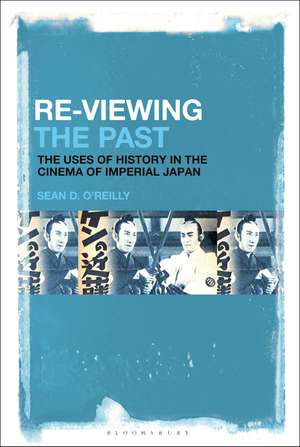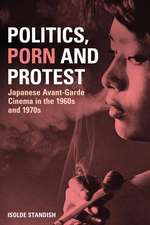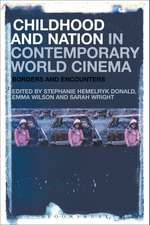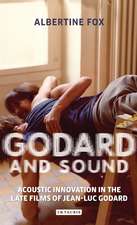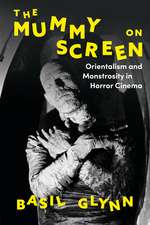Re-Viewing the Past: The Uses of History in the Cinema of Imperial Japan
Autor Professor Sean D. O’Reillyen Limba Engleză Hardback – 22 aug 2018
| Toate formatele și edițiile | Preț | Express |
|---|---|---|
| Paperback (1) | 225.96 lei 6-8 săpt. | |
| Bloomsbury Publishing – 19 feb 2020 | 225.96 lei 6-8 săpt. | |
| Hardback (1) | 775.09 lei 6-8 săpt. | |
| Bloomsbury Publishing – 22 aug 2018 | 775.09 lei 6-8 săpt. |
Preț: 775.09 lei
Preț vechi: 1113.67 lei
-30% Nou
Puncte Express: 1163
Preț estimativ în valută:
148.31€ • 155.27$ • 122.72£
148.31€ • 155.27$ • 122.72£
Carte tipărită la comandă
Livrare economică 05-19 aprilie
Preluare comenzi: 021 569.72.76
Specificații
ISBN-13: 9781501336027
ISBN-10: 1501336029
Pagini: 320
Ilustrații: 31 bw illus
Dimensiuni: 152 x 229 mm
Greutate: 0.59 kg
Editura: Bloomsbury Publishing
Colecția Bloomsbury Academic
Locul publicării:New York, United States
ISBN-10: 1501336029
Pagini: 320
Ilustrații: 31 bw illus
Dimensiuni: 152 x 229 mm
Greutate: 0.59 kg
Editura: Bloomsbury Publishing
Colecția Bloomsbury Academic
Locul publicării:New York, United States
Caracteristici
Includes a companion website with clips from these never-before-discussed films
Notă biografică
Sean D. O'Reilly is Assistant Professor at Akita International University, Japan, where he teaches courses on Japanese history, cinema, and popular culture. He graduated from Harvard University's History and East Asian Languages program with a secondary field in Film and Visual Studies.
Cuprins
1. Introduction2. Valorizing the Villains: the First Bakumatsu Boom and 1927's Sonno joi3. History as Nonsense: Historical Parodies of the Bakumatsu4. Serial History: the Case of Kurama Tengu5. Consuming History, Hating the Enemy6. Romancing History7. Transwar JapanBibliographyIndex
Recenzii
"O'Reilly re-views the films produced in transwar Japan through a unique analytical lens. The result is brisk and brilliant; he deciphers an intricate process whereby popular attitudes toward historicity were formulated by filmmakers, filmgoers, politicians, and foreigners-an unparalleled contribution to the scholarship on the history of Japan."
In Re-Viewing the Past, Sean O'Reilly lucidly introduces us to the barely discussed but deeply formative popular cinema of interwar and wartime Japan. Not content with simply mapping an immensely influential body of film, the book expertly re-directs us towards the complex encounters these films offered to audiences at the times. From the bloody tales of assassination, the parodies of patriotism and the adventures of masked heroes emerges a kaleidoscope of possible viewing positions that provides us with a rich view of how film in Japan functioned in negotiating the wrenching present through a specific framing of the tumultuous past.
Re-Viewing the Past makes a long-awaited contribution to the scholarship on Japanese period cinema, and Bakumatsu films in particular. Taking a Cultural Studies approach, Sean O'Reilly brilliantly conjures the multifaceted experiences of contemporary audiences, showing us that interwar/wartime Japan was not, in fact, a gloomy, 'dark valley' as is often claimed. O'Reilly's analysis is witty and elegantly sharp. With its innovative 'revisionist' approach, the book makes a major contribution to both the study of Japanese cinema and audience studies.
Our image of a monolithic, fascist Japan during WWII was partly the product of propaganda cinema from both Japan and the West; the reality was far more complex. Sean O'Reilly uncovers this complexity by looking at interwar and wartime films representing the Bakumatsu period, the 19th century transition from feudalism to the nation state system. His compelling analyses reveal the wide spectrum of relationships spectators held toward tradition, nation and war. Bakumatsu has recently made a comeback in film and television. O'Reilly invites us to use the insights of his study to understand how present-day audiences are also re-viewing their collective past.
In Re-Viewing the Past, Sean O'Reilly lucidly introduces us to the barely discussed but deeply formative popular cinema of interwar and wartime Japan. Not content with simply mapping an immensely influential body of film, the book expertly re-directs us towards the complex encounters these films offered to audiences at the times. From the bloody tales of assassination, the parodies of patriotism and the adventures of masked heroes emerges a kaleidoscope of possible viewing positions that provides us with a rich view of how film in Japan functioned in negotiating the wrenching present through a specific framing of the tumultuous past.
Re-Viewing the Past makes a long-awaited contribution to the scholarship on Japanese period cinema, and Bakumatsu films in particular. Taking a Cultural Studies approach, Sean O'Reilly brilliantly conjures the multifaceted experiences of contemporary audiences, showing us that interwar/wartime Japan was not, in fact, a gloomy, 'dark valley' as is often claimed. O'Reilly's analysis is witty and elegantly sharp. With its innovative 'revisionist' approach, the book makes a major contribution to both the study of Japanese cinema and audience studies.
Our image of a monolithic, fascist Japan during WWII was partly the product of propaganda cinema from both Japan and the West; the reality was far more complex. Sean O'Reilly uncovers this complexity by looking at interwar and wartime films representing the Bakumatsu period, the 19th century transition from feudalism to the nation state system. His compelling analyses reveal the wide spectrum of relationships spectators held toward tradition, nation and war. Bakumatsu has recently made a comeback in film and television. O'Reilly invites us to use the insights of his study to understand how present-day audiences are also re-viewing their collective past.
